XmAn complex is a defect with "n" atoms of B, As, C, F, O or P (called front particles), and "m" I or V (called back particles). DADOS does not take into account the different posible microscopic configurations of XmAn and uses effective numbers for each combination.
I and V can be single neutral native defects or associated with the other atoms, for instance, boron in interstitial position.
Back particles are emitted as follows:
XmAn -> Xm-1An + X
The emission frequency is calculated by DADOS as follows:

Where:
D0F_ComplexProp is a prefactor in diffusivities units.
Eb(m,n) = Etotal(m-1,n) - Etotal(m,n)
After emission, if only one particle (or two particles that can form a pair) is remaining, the complex is transformed into a point defect.
The energies associated to this process are plotted below:
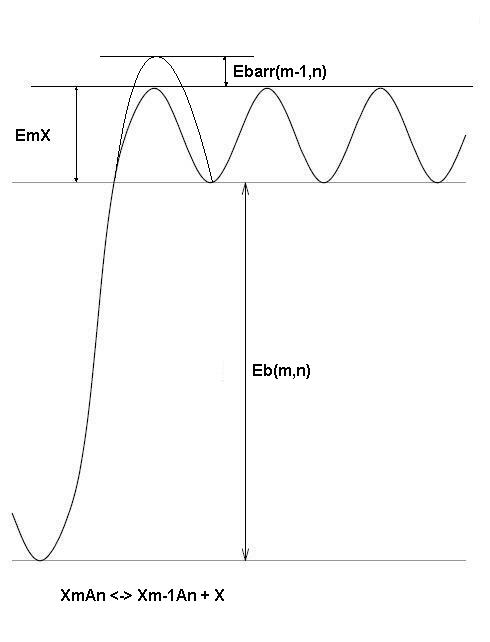
Front particles are emitted:
Mobile single impurity (F, O,...)XmAn -> XmAn-1 + A
The emission frequency is calculated by DADOS as follows:

Where:
D0F_ComplexProp is a prefactor in diffusivities units.
Eb(m,n) = Etotal(m,n-1) - Etotal(m,n)
After emission, if only one particle (or two particles that can form a pair) is remaining, the complex is transformed into a point defect.
The energies associated to this process are plotted below:
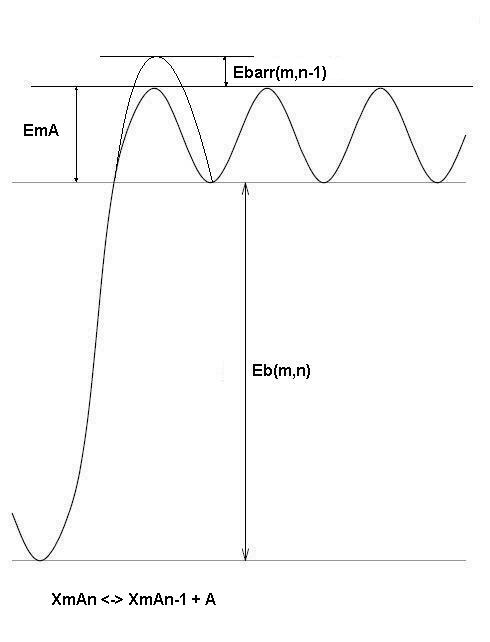
Immobile single impurity (B, As, C,...)
It is emitted within a mobile pair:
XmAn -> Xm-1An-1 + XA
The emission frequency is calculated by DADOS as follows:

Where:
D0F_ComplexProp is a prefactor in diffusivities units.
Eb(m,n) = Etotal(m-1,n-1) - EbXA-Etotal(m,n)
The energies associated to this process are plotted below:
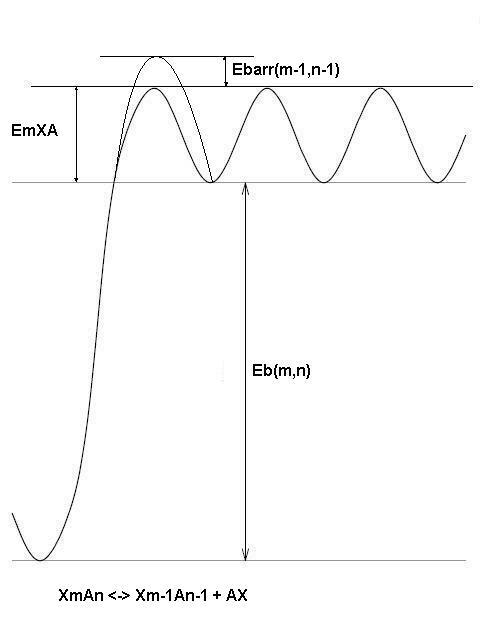
Complexes can capture single neutral "native defects".
XmAn + X -> Xm+1An
These captures are not automatic, because of the associated energies. DADOS uses a capture probability defined as follows:

Where:
Eb(m,n) = Etotal(m,n) - Etotal(m+1,n)
If there is no energy included in the DDP file, DADOS assumes that this configuration is unstable and it gives a value of +5 eV to the potential energy to avoid the creation of this kind of complexes.
The energies associated to this process are plotted below:
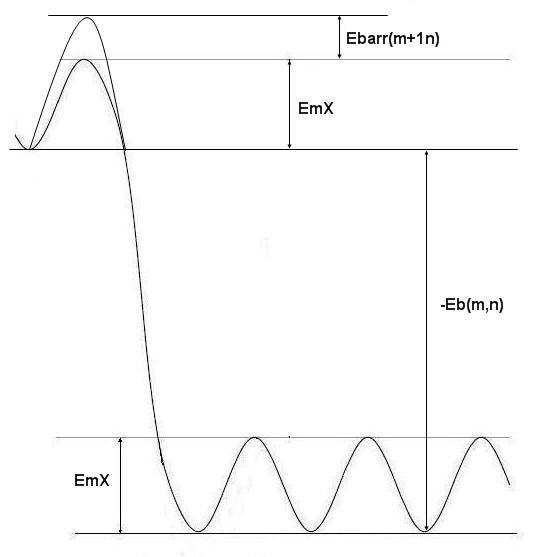
Complexes can capture single impurities:
Mobile single impurity (F, O,...)
XmAn + A -> XmAn+1
These captures are not automatic, because of the associated energies. DADOS uses a capture probability defined as follows:

Where:
Eb(m,n) = Etotal(m,n) - Etotal(m,n+1)
The energies associated to this process are plotted below:
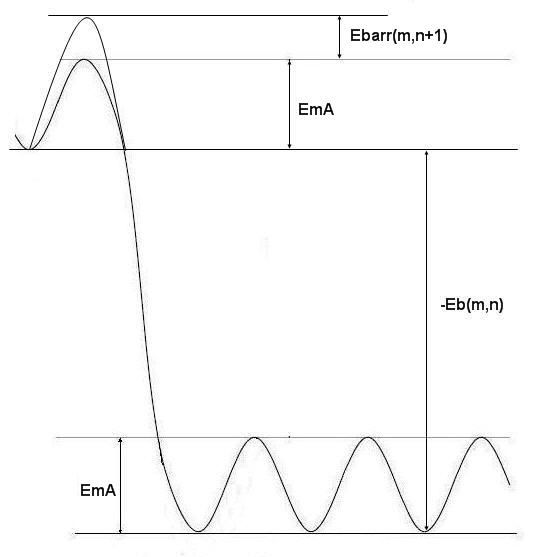
Immobile single impurity (B, As, C,...)
XmAn + XA -> Xm+1An+1
These captures are not automatic, because of the associated energies. DADOS uses a capture probability defined as follows:

Where:
Eb(m,n) = Etotal(m,n) - Etotal(m+1,n+1)
The energies associated to this process are plotted below:
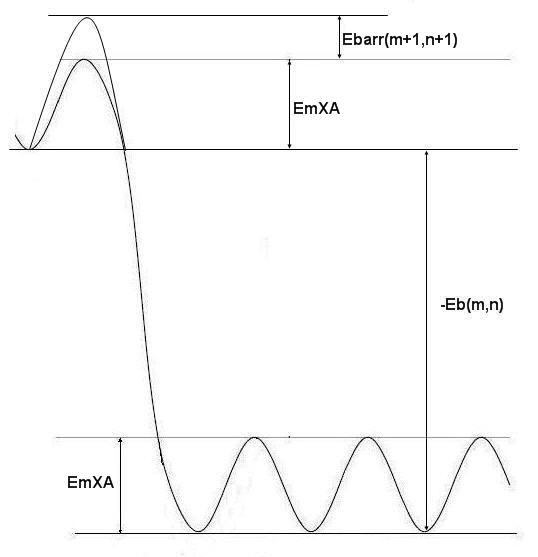
Complexes can capture interstitials or vacancies that are recombined with complementary particles. For instance, let's call X' to the complementary particle to X, i. e., interstitials for vacancies and vice versa:
XmAn + X' -> Xm-1An
The capture probability is calculated as follows:

Where:
Erec(m,n) = Eform_I + Eform_V - (Etotal(m-1,n) -
Etotal(m,n)) = Eform_I + Eform_V - EbB(m,n)
The energies associated to this process are plotted below:
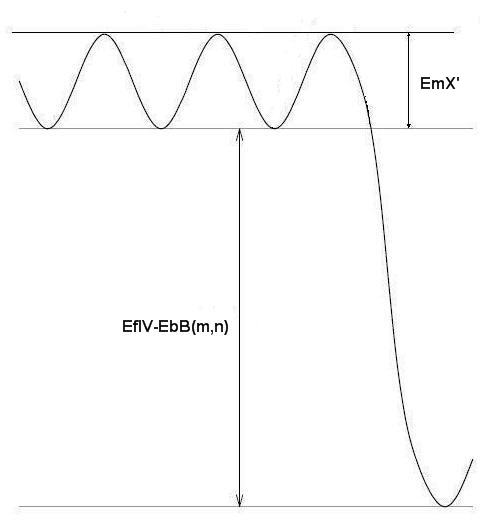
Some impurities can diffuse by means of both interstitals and vacancies, for example, arsenic. In this case, complexes can emit not only interstitials and vacancies but also point defects, with complementary particles, i.e., a AsnVm complex can emit Asi.
XmAn -> Xm+1An-1 + X'A
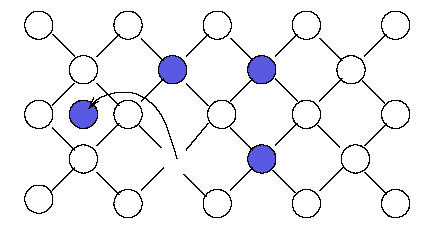
The emission frequency is given as follows (the same for AV):

Where:
D0F_ComplexProp is a prefactor in diffusivities units.
Em is the migration energy.
Ebarr is an optional energetic barrier.
Eb is the binding energy, calculated as follows:
Some impurities can diffuse by means of both interstitals and vacancies, for example, arsenic. In this case, complexes can recombine not only interstitials and vacancies but also point defects:
XmAn + X'A -> Xm-1An+1
The capture probability is calculated as follows:

Where:
And the recombination energy is calculated with the total energies:

Where: